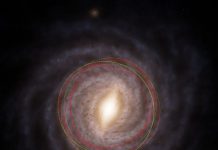
In new research, Brazilian astronomers have discovered an exoplanet orbiting an older or more evolved binary.
In the binary, one of the two stars is dead.
This is the first confirmation of an exoplanet in a system of this kind.
The study was done by a team from the Federal University of Rio Grande do Norte (UFRN).
Previous research has discovered almost 4,000 planet-like objects orbiting isolated stars outside the solar system (exoplanets).
The NASA’s Kepler Space Telescope has provided chances to observe the first exoplanets in orbit around young binary systems of two live stars.
In the current study, the team found solid evidence of a giant exoplanet with a mass almost 13 times that of Jupiter in an evolved binary system.
The evolved binary is called KIC 10544976 and located in the Cygnus constellation in the northern celestial hemisphere.
It consists of a white dwarf, which a dead, low-mass star with a high surface temperature; and a red dwarf, a live star with a small mass compared to that of the sun.
Scientists monitored the two stars with ground-based telescopes between 2005 and 2017 and by Kepler between 2009 and 2013.
In the current study, the researchers discovered the exoplanet based on the variations in eclipse timing and orbital period.
They suggest that variations in the orbital period of a binary are caused by gravitational attraction among the three objects.
Besides the orbital period variations, the team also analyzed the effect of eclipse timing variation and the magnetic activity cycle of the binary’s live star using the Kepler data.
They estimated the magnetic cycle of the live star based on the rate and energy of flares and variability due to spots.
They found that the red dwarf’s magnetic activity cycle lasted 600 days. This is consistent with the magnetic cycles estimated for low-mass isolated stars.
The findings are against the hypothesis that orbital period variation is due to magnetic activity.
They suggest that it is very possible that there is a giant planet orbiting the binary, with a mass approximately 13 times that of Jupiter.
Future work needs to examine the formation and evolution of the exoplanet and the possibility of life there.
The lead author of the study is Leonardo Andrade de Almeida.
The study is published in the Astronomical Journal from the American Astronomical Society (AAS).
Copyright © 2019 Knowridge Science Report. All rights reserved.



